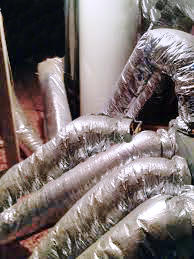As the marketplace demands more energy-efficient  homes, the performance of something as unimposing as the HVAC system can make a huge difference, leading to the requirement for contractors to not only offer higher-quality levels of products and services, but to look at ways to improve heating and cooling system operation.
homes, the performance of something as unimposing as the HVAC system can make a huge difference, leading to the requirement for contractors to not only offer higher-quality levels of products and services, but to look at ways to improve heating and cooling system operation.
One area that is often overlooked, but is extremely critical, is air flow. HVAC equipment SEER ratings are based on a manufacturer’s efficiency rating, with no resistance factored in for the duct system. A bad duct system will cause the equipment to work harder and less efficiently.
Most building codes fail to address air flow during a duct installation inspection. As long as it is properly sealed and insulated, it will most often pass the inspection, leading contractors to think that the system is good. But this sets the bar at its lowest level of performance.
Improper Duct Installation Causes Air Flow Problems
Air flow problems have plagued the HVAC industry for years, and unfortunately some contractors believe that installing oversized equipment will address the problem. A common mistake made by duct installers is to not cut off the excess lengths of flex duct prior to making connections. This compresses the excess flex duct like an accordion, whereas it functions much more efficiently when the flexible duct is fully stretched. For example, a 10-foot-long section installed into a 7-foot-long area results in a 30% compression.
When air flows over the accordianed flex duct it encounters friction, which in turn reduces the unit’s efficiency. Studies reported that even the smallest amounts of compression dramatically increased friction losses. Our previous example of a 30% compression can equal a 10X efficiency loss.
However, compression is just one installation variable. Excessive bending and crimping can also have an impact when installers simply install the entire length and don’t cut off the excess flex duct material.
The Conservation Services Group (CSG) published “ENERGY STAR HOMES Technical Standards” that recommends avoiding flex duct when possible. It notes that flexible duct running longer than five feet can severely restrict airflow, and to keep flex ducts as short and straight as possible.
One of the best types of duct material is galvanized sheet metal. It is the most durable, efficient and clean as an air distribution system. In addition, the galvanized coating actually kills mold and offers excellent protection against organic growth. However, it can also conduct sound, as its surface is hard and smooth.
The alternative is a hybrid duct system, combining metal duct work with flexible duct. This generally consists of a mostly-metal duct system with short (3-5 feet) flexible ducts at the end of the duct run. This maximizes the efficiency of the metal duct while minimizing HVAC noise at the final connection to the register.
As the economy tightens, contractors look for ways to tighten their expenditures, perhaps at the expense of quality and performance. Although higher federal standards and technological advances have created significant improvements in HVAC equipment, the quality of the duct systems and system installation has declined. Contractors look for the “easy to install” methods rather than ones that could possible operate more efficiently.
As a homeowner, you can insist on proper duct sizing and installation and the use of a sheet metal or hybrid duct system as an upgrade.
According to the Consortium for Energy Efficiency (CEE) “most residential central air conditioning systems are not installed properly.” Their research reports 70% inadequate air flow, 47% oversized equipment, and 44% improper refrigerant charge. They also suggest that correcting these problems could reduce air conditioning costs by an average of 24% in existing homes and 35% in new construction.
How Först Consulting Group Can Help
There are several ways that Först Consulting Group can assist you in increasing your HVAC performance.
- Consulting when you are in the planning stages of building a new home.
- Consulting prior to remodeling or replacement of the HVAC system
- With an HVAC inspection
- As a construction project manager
The best time to address the ductwork system is in advance. This way, Först can help you determine your needs and identify the correct size and type of equipment needed. Consider us your homeowner advocate. We can create standards which are then shared with your contractor to ensure that the right installation and installation practices are performed from the beginning.
If you are remodeling or need to install a new HVAC system, Först can also consult with you for the same outcome—more energy efficiency and lower heating and cooling costs. Knowing what you need, you are better equipped to give guidance to your installer or contractors.
Thirdly, if you suspect that your HVAC system is not operating to its best capacity, call in Först to perform a comprehensive inspection. We can identify areas that can be improved and even estimate costs to remediate the problem. This arms you when hiring your HVAC professional. If desired, Först can even act as your “go-between” as your construction project manager to negotiate and monitor the project to your specifications.
If you are located in Northern Virginia or the Washington, D.C. metropolitan area, we’ll be glad to help. Please contact Först Consulting Group today.
–excerpted from “Airflow is Critical to HVAC System Performance,” by Chris Van Rite, M&M Manufacturing Company.




